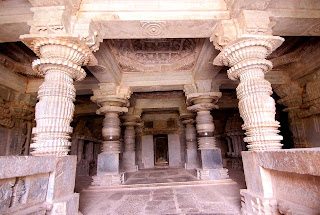During the 12th and 13th centuries AD, Halebid was the regal capital of the Hoysala Dynasty. Literally meaning 'the ruined city', Hoysala was also known by other aliases such as Dwarasamudra, which is derived from the vast tank known as Dwarasamudra.
This magnificent temple town has to bear the brunt of raids by marauding invaders, who robbed it of its treasures, leaving behind the ruins of the once-magnificent Shiva temple. In the face of persistent attacks, the Hoysalas then relocated their capital to Belur and this royal capital gradually reduced to a state of dilapidation and ruins.
The Hoysaleshwara and Kedareshwara temples in Halebidu are supreme examples of Hoysala temple architecture. Hoysaleshwara temple was built by Ketamala and attributed to Vishnuvardhana, the Hoysala ruler. It enshrines the deities of Hoysaleswara and Santaleswara, named after the king Vishnuvardhana Hoysala and his wife, Queen Santala.
The Hoysala temples are manifestations of the Vesara style of temple architecture characterized by star-shaped structures set upon raised platforms. The Vesara style was initiated by the Badami Chalukyas and further refined by the Kalyani Chalukyas. Nowadays, a vibrant tourism industry has emerged in Halebid around these fabulous temples.
Places to See:
A gem of Hoysala temple architecture, the Hoysaleshwara temple is ornamented with a plethora of exquisite carvings and sculptures. It was built by Ketamalla, a minister of Hoysala ruler Vishnuvardhana, in the 12th century AD.
Archaeological Museum
The landscaped garden in front of the Hoysaleshwara Temple serves as an Archaeological Museum. The museum houses the idols, statues, busts, and sculptures excavated by the Archaeological Department from the ruins. It is open daily from 10 a.m. to 5 p.m. Closed on Fridays.
Basadi Halli
The Basadi Halli locates a number of Jain monasteries. The Parshwanatha Swamy temple possesses a 14 feet high statue of Parshwanatha Swamy made of gleaming black stone. A seven-headed serpent has been carved on the head of this figure.
Kedareshwara Temple
Built in 1319 AD by Veeraballala II and his younger Queen Abhinva Ketala Devi, the Kedareshwara temple is a collapsed structure that has not been restored to its original shape. Besides the exquisitely carved walls and the ceiling, the basement of the temple exhibits a profusion of sculptured friezes depicting stories of Ramayana, Mahabharata and Bhagavad-Gita.





No comments:
Post a Comment